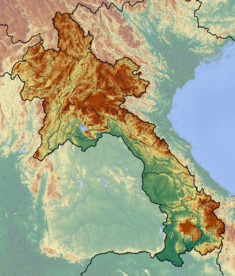Xayaburi Dam
| Xayaburi Dam | |
|---|---|
|
Location of Xayaburi Dam in Laos
|
|
| Country | Laos |
| Location | Xayaburi |
| Coordinates | 19°15′14.46″N 101°48′49.2″E / 19.2540167°N 101.813667°ECoordinates: 19°15′14.46″N 101°48′49.2″E / 19.2540167°N 101.813667°E |
| Status | Under construction |
| Construction began | 2012 |
| Opening date | 2020 |
| Construction cost | US$3.8 billion |
| Owner(s) | CH. Karnchang Public Company |
| Dam and spillways | |
| Impounds | Mekong |
| Height | 32.6 m (107 ft) |
| Length | 820 m (2,690 ft) |
| Spillway type | 10 x radial gates |
| Spillway capacity | 3,980 m3/s (141,000 cu ft/s) |
| Reservoir | |
| Total capacity | 1.3 km3 (1,100,000 acre·ft) |
| Catchment area | 272,000 km2 (105,000 sq mi) |
| Surface area | 49 km2 (19 sq mi) |
| Power station | |
| Hydraulic head | 18 m (59 ft) (rated) |
| Turbines |
EDL: 1 × 60 MW EGAT: 7 x 175 MW |
| Installed capacity | 1,285 MW (max. planned) |
The Xayaburi Dam is a hydroelectric dam on the Lower Mekong River approximately 30 kilometres (19 mi) east of Xayaburi (Sainyabuli) town in northern Laos. In 2019, commercial operation is scheduled to start. The main purpose of the dam is to produce hydroelectric power. The project is surrounded in controversy due to complaints from downstream riparians and environmentalists. Preliminary construction began in early-2012, but work on the dam itself was suspended shortly thereafter due to complaints from Cambodia and Vietnam downstream. After making modifications to the dam's design, Laos plans to start full construction with a ceremony on 7 November 2012. The Xayaburi Dam is the first of the 11 dams planned on the lower Mekong.
On 4 May 2007, the Lao government signed a memorandum of understanding with Thailand's CH. Karnchang Public Company for the development of this hydropower project. The formal project development agreement followed in November 2008, and a feasibility study was conducted that same year by Swiss-based AF Colenco and Thai TEAM consultants. The environmental impact assessment was submitted in February 2010. In July 2010, a memorandum of understanding for power purchase was signed between the Electricity Generating Authority of Thailand (EGAT) and the Lao government.
According to the 1995 Mekong Agreement, the project is subject to the Mekong River Commission (MRC) Procedures for Notification, Prior Consultation, and Agreement. Under this agreement, the project's host country must notify the governments of the other signatories, namely Cambodia, Thailand, and Vietnam. The process was initiated in September 2010. It is the first project initiated through a regional decision-making process.
On 19 April 2011, the MRC Joint Committee announced that the MRC countries could not reach a consensus on how to proceed with the project, and agreed that a decision on the prior consultation process be tabled for consideration at the ministerial level. However, in June 2011, the Laos Government gave the Thai developer CH. Karnchang the go-ahead to resume work on the Xayaburi Dam, informing the company that the Mekong River Commission's decision-making process was completed. Prashanth Parameswaran, a former researcher at the Project 2049 Institute, who is conducting research on dam projects in Southeast Asia, warned, "Laos' actions not only represent a breach of trust, but threaten to undermine already fledgling efforts at regional cooperation in an ecosystem that supports the livelihoods of tens of millions of people."
...
Wikipedia

